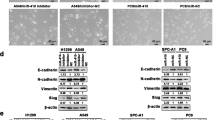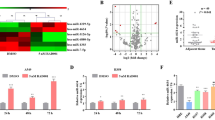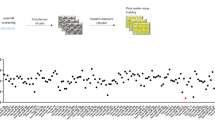Abstract
Accumulating evidence has demonstrated that microRNA-519a (miR-519a) acts as the tumor suppressor in various cancers, but little is known regarding its intrinsic regulatory mechanisms in non-small cell lung cancer (NSCLC). Here, we aimed to investigate the role of miR-519a-targeted ephrinA2 receptor (EphA2) in radiosensitivity of NSCLC. MiR-519a and EphA2 expression in NSCLC and paracancerous tissues were detected using RT-qPCR and western blot analysis. A549 cell line was cultured and radiation-resistant cell line A549R was constructed using fractionated X-ray irradiation of these cells at 60 Gy. Colony formation ability and radioresistance of parent strain A549 and resistant strain A549R were detected with restored miR-519a and depleted EphA2. MTT assay was used to measure cell proliferation, flow cytometry was performed for determination of cell cycle distribution and apoptosis. The migration and invasion abilities were assessed by Transwell assay. The target relationship between miR-519a and EphA2 was verified. Results suggested that miR-519a was downregulated and EphA2 was upregulated in NSCLC tissues and cells, and miR-519a targeted EphA2. MiR-519a expression declined, while EphA2 expression elevated in A549R cells versus A549 cells. Upregulated miR-519a and downregulated EphA2 suppressed D0, Dq, survival fraction (SF2) and N-value, arrested cells at G0/G1 phase, advanced the apoptosis and attenuated migration, proliferation, and invasion of A549 and A549R cells. Overexpression of EphA2 reversed the promotion of upregulated miR-519a on radiosensitivity of NSCLC cells. Our results revealed that miR-519a enhances radiosensitivity of NSCLC by inhibiting EphA2 expression. Moreover, miR-519a serves as a target for NSCLC treatment.
This is a preview of subscription content, access via your institution
Access options
Subscribe to this journal
Receive 12 print issues and online access
$259.00 per year
only $21.58 per issue
Buy this article
- Purchase on Springer Link
- Instant access to full article PDF
Prices may be subject to local taxes which are calculated during checkout






Similar content being viewed by others
References
Fidler MM, Bray F, Soerjomataram I. The global cancer burden and human development: a review. Scand J Public Health. 2018;46:27–36.
Liu Y, Xing Y, Wang H, Yan S, Wang X, Cai L. LRH1 as a promising prognostic biomarker and predictor of metastasis in patients with non-small cell lung cancer. Thorac Cancer. 2018;9:1725–32.
Xu JH, Yang HP, Zhou XD, Wang HJ, Gong L, Tang CL. Autophagy accompanied with bisdemethoxycurcumin-induced apoptosis in non-small cell lung cancer cells. Biomed Environ Sci. 2015;28:105–15.
Erbasoglu KO, Horozoğlu C, Ercan Ş, Kara HV, Turna A, Farooqi AA, et al. Effect of trail C1595T variant and gene expression on the pathogenesis of non-small cell lung cancer. Libyan J Med. 2019;14:1535746.
Ettinger DS, Wood DE, Akerley W, Bazhenova LA, Borghaei H, Camidge DR, et al. NCCN guidelines insights: non-small cell lung cancer, version 4.2016. J Natl Compr Cancer Netw. 2016;14:255–64.
Wang L, Xia Y, Chen T, Zeng Y, Li L, Hou Y, et al. Sanyang Xuedai enhances the radiosensitivity of human non-small cell lung cancer cells via increasing iNOS/NO production. Biomed Pharmacother. 2018;102:618–25.
Miller KD, Siegel RL, Lin CC, Mariotto AB, Kramer JL, Rowland JH, et al. Cancer treatment and survivorship statistics, 2016. CA Cancer J Clin. 2016;66:271–89.
Behzadi FS, Mazaheri Z, Ghorbanmehr N, Movahedin M, Fard MB, Gholampour MA. Analysis of MiRNA-17 and MiRNA-146 expression during differentiation of spermatogonial stem like cells derived from mouse bone marrow mesenchymal stem cells. Int J Mol Cell Med. 2019;8:14–23.
Zi Y, Xu M, Li P. miRNA-221 acts as an oncogenic role by directly targeting TIMP2 in non-small-cell lung carcinoma. Gene. 2017;620:46–53.
Dong Z, Yang P, Qiu X, Liang S, Guan B, Yang H, et al. KCNQ1OT1 facilitates progression of non-small-cell lung carcinoma via modulating miRNA-27b-3p/HSP90AA1 axis. J Cell Physiol. 2019;234:11304–14.
Lewis A, Lee JY, Donaldson AV, Natanek SA, Vaidyanathan S, Man WDC, et al. Increased expression of H19/miR-675 is associated with a low fat-free mass index in patients with COPD. J Cachexia Sarcopenia Muscle. 2016;7:330–44.
Tang H, Han X, Li M, Li T, Hao Y. Linc00221 modulates cisplatin resistance in non-small-cell lung cancer via sponging miR-519a. Biochimie. 2019;162:134–43.
Good RJ, Hernandez-Lagunas L, Allawzi A, Maltzahn JK, Vohwinkel CU, Upadhyay AK, et al. MicroRNA dysregulation in lung injury: the role of the miR-26a/EphA2 axis in regulation of endothelial permeability. Am J Physiol Lung Cell Mol Physiol. 2018;315:L584–L594.
Lee HY, Mohammed KA, Kaye F, Sharma P, Moudgil BM, Clapp WL, et al. Targeted delivery of let-7a microRNA encapsulated ephrin-A1 conjugated liposomal nanoparticles inhibit tumor growth in lung cancer. Int J Nanomedicine. 2013;8:4481–94.
Wu Q, Xu L, Wang C, Fan W, Yan H, Li Q. MicroRNA-124-3p represses cell growth and cell motility by targeting EphA2 in glioma. Biochem Biophys Res Commun. 2018;503:2436–42.
Amato KR, Wang S, Hastings AK, Youngblood VM, Santapuram PR, Chen H, et al. Genetic and pharmacologic inhibition of EPHA2 promotes apoptosis in NSCLC. J Clin Investig. 2014;124:2037–49.
Lee HY, Mohammed KA, Kaye F, Moudgil BM, Nasreen N. EphA2 targeted intratumoral therapy for non-small cell lung cancer using albumin mesospheres. Am J Transl Res. 2017;9:3293–303.
Rusch VW, Chansky K, Kindler HL, Nowak AK, Pass HI, Rice DC, et al. The IASLC Mesothelioma Staging Project: proposals for the M descriptors and for revision of the TNM stage groupings in the forthcoming (Eighth) edition of the TNM classification for mesothelioma. J Thorac Oncol. 2016;11:2112–9.
Xu J, Lu M, Cui Y, Du Y. Selection and evaluation of reference genes for expression analysis using qRT-PCR in Chilo suppressalis (Lepidoptera: Pyralidae). J Econ Entomol. 2017;110:683–91.
Wang D, Han X, Li C, Bai W. FBXL3 is regulated by miRNA-4735-3p and suppresses cell proliferation and migration in non-small cell lung cancer. Pathol Res Pract. 2019;215:358–65.
Li N, Liu S, Sun M, Chen Wei, Xu X, Zeng Z, et al. Chimeric antigen receptor-modified T cells redirected to EphA2 for the immunotherapy of non-small cell lung cancer. Transl Oncol. 2018;11:11–17.
Zhao RS, Wang W, Li J, Liu C, He L. Gelsolin promotes radioresistance in non-small cell lung cancer cells through activation of phosphoinositide 3-kinase/Akt signaling. Technol Cancer Res Treat. 2017;16:512–8.
Pan X, Wang R, Bian H, De W, Zhang P, Wei C, et al. Overexpression of inhibitor of growth 4 enhances radiosensitivity in non-small cell lung cancer cell line SPC-A1. Technol Cancer Res Treat. 2017;16:533–45.
Abdelmohsen K, Kim MM, Srikantan S, Mercken EM, Brennan SE, Wilson GM, et al. miR-519 suppresses tumor growth by reducing HuR levels. Cell Cycle. 2010;9:1354–9.
Ishikawa M, Miyahara R, Sonobe M, Horiuchi M, Mennju T, Nakayama., et al. Higher expression of EphA2 and ephrin-A1 is related to favorable clinicopathological features in pathological stage I non-small cell lung carcinoma. Lung Cancer. 2012;76:431–8.
Song W, Ma Y, Wang J, Brantley-Sieders D, Chen J. JNK signaling mediates EPHA2-dependent tumor cell proliferation, motility, and cancer stem cell-like properties in non-small cell lung cancer. Cancer Res. 2014;74:2444–54.
Li G, Huang M, Cai Y, Ke Yiquan, Yang Y, Sun X. miR141 inhibits glioma vasculogenic mimicry by controlling EphA2 expression. Mol Med Rep. 2018;18:1395–404.
Tian F, Jia L, Chu Z, Han H, Zhang Y, Cai J. MicroRNA-519a inhibits the proliferation and promotes the apoptosis of ovarian cancer cells through targeting signal transducer and activator of transcription 3. Exp Ther Med. 2018;15:1819–24.
Hong L, Ya-Wei L, Hai W, Qiang Z, Jun-Jie L, Huang A, et al. MiR-519a functions as a tumor suppressor in glioma by targeting the oncogenic STAT3 pathway. J Neurooncol. 2016;128:35–45.
Brannan JM, Sen B, Saigal B, Prudkin L, Behrens C, Solis L, et al. EphA2 in the early pathogenesis and progression of non-small cell lung cancer. Cancer Prev Res. 2009;2:1039–49.
Qiao J, Li XJ, Cao PG. MicroRNA-26b enhances the radiosensitivity of hepatocellular carcinoma cells by targeting EphA2. Tohoku J Exp Med. 2016;238:143–51.
Acknowledgements
We would like to acknowledge the reviewers for their helpful comments on this paper.
Author information
Authors and Affiliations
Corresponding author
Ethics declarations
Conflict of interest
The authors declare that they have no conflict of interest.
Ethical approval
The study was endorsed by the Institutional Review Board of the first affiliated hospital of China medical university. All participants signed a document of informed consent.
Additional information
Publisher’s note Springer Nature remains neutral with regard to jurisdictional claims in published maps and institutional affiliations.
Rights and permissions
About this article
Cite this article
Gong, S., Li, Y., Lv, L. et al. Restored microRNA-519a enhances the radiosensitivity of non-small cell lung cancer via suppressing EphA2. Gene Ther 29, 588–600 (2022). https://doi.org/10.1038/s41434-020-00213-x
Received:
Revised:
Accepted:
Published:
Issue Date:
DOI: https://doi.org/10.1038/s41434-020-00213-x
This article is cited by
-
Eph receptors and ephrins in cancer progression
Nature Reviews Cancer (2024)
-
Targeting EphA2: a promising strategy to overcome chemoresistance and drug resistance in cancer
Journal of Molecular Medicine (2024)



